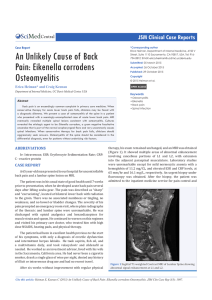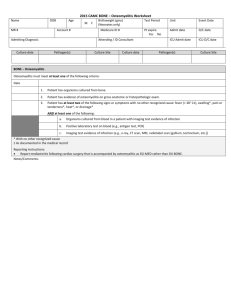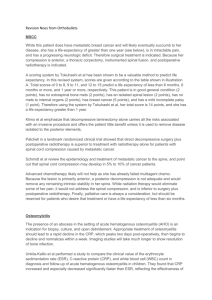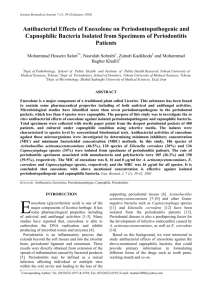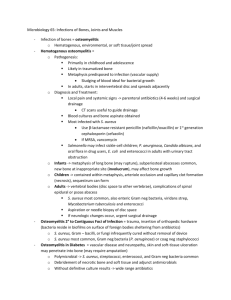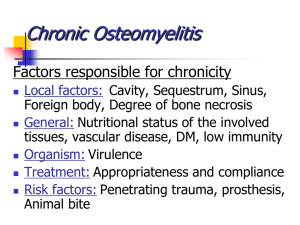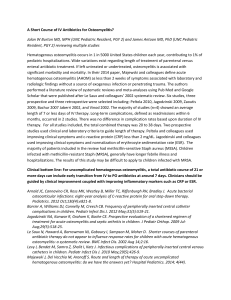Q U I C K S TA RT ...
advertisement
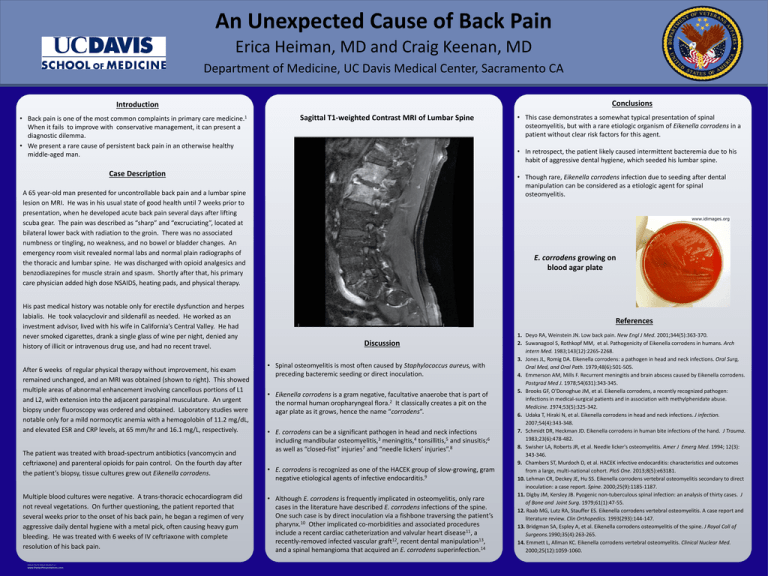
An Unexpected Cause of Back Pain Erica Heiman, MD and Craig Keenan, MD Department of Medicine, UC Davis Medical Center, Sacramento CA Conclusions Introduction • Back pain is one of the most common complaints in primary care medicine.1 When it fails to improve with conservative management, it can present a diagnostic dilemma. • We present a rare cause of persistent back pain in an otherwise healthy middle-aged man. Sagittal T1-weighted Contrast MRI of Lumbar Spine • In retrospect, the patient likely caused intermittent bacteremia due to his habit of aggressive dental hygiene, which seeded his lumbar spine. Case Description • Though rare, Eikenella corrodens infection due to seeding after dental manipulation can be considered as a etiologic agent for spinal osteomyelitis. A 65 year-old man presented for uncontrollable back pain and a lumbar spine lesion on MRI. He was in his usual state of good health until 7 weeks prior to presentation, when he developed acute back pain several days after lifting scuba gear. The pain was described as “sharp” and “excruciating”, located at bilateral lower back with radiation to the groin. There was no associated numbness or tingling, no weakness, and no bowel or bladder changes. An emergency room visit revealed normal labs and normal plain radiographs of the thoracic and lumbar spine. He was discharged with opioid analgesics and benzodiazepines for muscle strain and spasm. Shortly after that, his primary care physician added high dose NSAIDS, heating pads, and physical therapy. His past medical history was notable only for erectile dysfunction and herpes labialis. He took valacyclovir and sildenafil as needed. He worked as an investment advisor, lived with his wife in California’s Central Valley. He had never smoked cigarettes, drank a single glass of wine per night, denied any history of illicit or intravenous drug use, and had no recent travel. After 6 weeks of regular physical therapy without improvement, his exam remained unchanged, and an MRI was obtained (shown to right). This showed multiple areas of abnormal enhancement involving cancellous portions of L1 and L2, with extension into the adjacent paraspinal musculature. An urgent biopsy under fluoroscopy was ordered and obtained. Laboratory studies were notable only for a mild normocytic anemia with a hemogolobin of 11.2 mg/dL, and elevated ESR and CRP levels, at 65 mm/hr and 16.1 mg/L, respectively. The patient was treated with broad-spectrum antibiotics (vancomycin and ceftriaxone) and parenteral opioids for pain control. On the fourth day after the patient’s biopsy, tissue cultures grew out Eikenella corrodens. Multiple blood cultures were negative. A trans-thoracic echocardiogram did not reveal vegetations. On further questioning, the patient reported that several weeks prior to the onset of his back pain, he began a regimen of very aggressive daily dental hygiene with a metal pick, often causing heavy gum bleeding. He was treated with 6 weeks of IV ceftriaxone with complete resolution of his back pain. RESEARCH POSTER PRESENTATION DESIGN © 2012 www.PosterPresentations.com • This case demonstrates a somewhat typical presentation of spinal osteomyelitis, but with a rare etiologic organism of Eikenella corrodens in a patient without clear risk factors for this agent. E. corrodens growing on blood agar plate References Discussion • Spinal osteomyelitis is most often caused by Staphylococcus aureus, with preceding bacteremic seeding or direct inoculation. • Eikenella corrodens is a gram negative, facultative anaerobe that is part of the normal human oropharyngeal flora.2 It classically creates a pit on the agar plate as it grows, hence the name “corrodens”. • E. corrodens can be a significant pathogen in head and neck infections including mandibular osteomyelitis,3 meningitis,4 tonsillitis,5 and sinusitis;6 as well as “closed-fist” injuries7 and “needle lickers’ injuries”.8 • E. corrodens is recognized as one of the HACEK group of slow-growing, gram negative etiological agents of infective endocarditis.9 • Although E. corrodens is frequently implicated in osteomyelitis, only rare cases in the literature have described E. corrodens infections of the spine. One such case is by direct inoculation via a fishbone traversing the patient’s pharynx.10 Other implicated co-morbidities and associated procedures include a recent cardiac catheterization and valvular heart disease11, a recently-removed infected vascular graft12, recent dental manipulation13, and a spinal hemangioma that acquired an E. corrodens superinfection.14 1. Deyo RA, Weinstein JN. Low back pain. New Engl J Med. 2001;344(5):363-370. 2. Suwanagool S, Rothkopf MM, et al. Pathogenicity of Eikenella corrodens in humans. Arch intern Med. 1983;143(12):2265-2268. 3. Jones JL, Romig DA. Eikenella corrodens: a pathogen in head and neck infections. Oral Surg, Oral Med, and Oral Path. 1979;48(6):501-505. 4. Emmerson AM, Mills F. Recurrent meningitis and brain abscess caused by Eikenella corrodens. Postgrad Med J. 1978;54(631):343-345. 5. Brooks GF, O'Donoghue JM, et al. Eikenella corrodens, a recently recognized pathogen: infections in medical-surgical patients and in association with methylphenidate abuse. Medicine. 1974;53(5):325-342. 6. Udaka T, Hiraki N, et al. Eikenella corrodens in head and neck infections. J infection. 2007;54(4):343-348. 7. Schmidt DR, Heckman JD. Eikenella corrodens in human bite infections of the hand. J Trauma. 1983;23(6):478-482. 8. Swisher LA, Roberts JR, et al. Needle licker's osteomyelitis. Amer J Emerg Med. 1994; 12(3): 343-346. 9. Chambers ST, Murdoch D, et al. HACEK infective endocarditis: characteristics and outcomes from a large, multi-national cohort. PloS One. 2013;8(5):e63181. 10. Lehman CR, Deckey JE, Hu SS. Eikenella corrodens vertebral osteomyelitis secondary to direct inoculation: a case report. Spine. 2000;25(9):1185-1187. 11. Digby JM, Kersley JB. Pyogenic non-tuberculous spinal infection: an analysis of thirty cases. J of Bone and Joint Surg. 1979;61(1):47-55. 12. Raab MG, Lutz RA, Stauffer ES. Eikenella corrodens vertebral osteomyelitis. A case report and literature review. Clin Orthopedics. 1993(293):144-147. 13. Bridgman SA, Espley A, et al. Eikenella corrodens osteomyelitis of the spine. J Royal Coll of Surgeons.1990;35(4):263-265. 14. Emmett L, Allman KC. Eikenella corrodens vertebral osteomyelitis. Clinical Nuclear Med. 2000;25(12):1059-1060.
